Fantasy
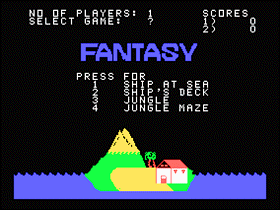 The Game: Pirates have kidnapped your girlfriend, Cheri, and it’s your job to rescue her, from landing your hot air balloon on the deck of the pirate ship and trying to free her, to flying and climbing your way through the jungle to rescue her from jungle animals who have abducted her from the pirates. (Texas Instruments, 1983 [unreleased])
The Game: Pirates have kidnapped your girlfriend, Cheri, and it’s your job to rescue her, from landing your hot air balloon on the deck of the pirate ship and trying to free her, to flying and climbing your way through the jungle to rescue her from jungle animals who have abducted her from the pirates. (Texas Instruments, 1983 [unreleased])
Memories: Several years ago, when I wrote up my all-time favorite coin-op, SNK‘s adventurous gem Fantasy (licensed for the US by Rock-Ola), I lamented the lack of a home version. I’ve always thought Fantasy was underappreciated as an arcade game, and a good home translation might have helped. I remember, around the time that NAP finally licensed an arcade game (Turtles) for the Odyssey2, I wrote a letter to them to make the case for an Odyssey2 version of Fantasy, since it now seemed like they were prepared to license arcade titles. When my Fantasy review appeared many years later, TI 99/4a uber-fan Bryan Roppolo wrote in to bring my attention to an unreleased version of the game that had been in the works for that computer system, and I’ve always wondered if it was as much fun as the arcade game.
Battlezone
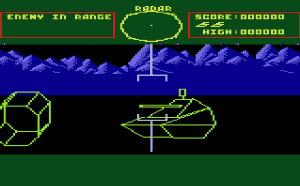 The Game: As the pilot of a heavy tank, you wander the desolate battlefield, trying to wipe out enemy tanks and landing vehicles. (Atari, 1983)
The Game: As the pilot of a heavy tank, you wander the desolate battlefield, trying to wipe out enemy tanks and landing vehicles. (Atari, 1983)
Memories: If Atari’s 2600 version of the arcade wargame was a pleasant surprise, the unreleased 5200 edition of the same game is almost a revelation. Combining adaptations of the menacingly angular vector graphics of the arcade game with more realistic raster backgrounds, the 5200 prototype is not only fun, but rather pretty to look at.
RealSports Basketball
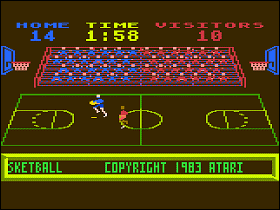 The Game: Two players each control one man in one-on-one, full-court action. Whoever has the highest score by a predetermined time limit wins. (Atari, 1983 [unreleased])
The Game: Two players each control one man in one-on-one, full-court action. Whoever has the highest score by a predetermined time limit wins. (Atari, 1983 [unreleased])
Memories: Atari’s RealSports series was created to challenge the upper hand Intellivision’s sports games had gained over the blocky, primitive virtual versions of the same sports on the Atari 2600. The RealSports brand was extended into the 5200 line as well, and did manage to score some firsts, including the first home video game to offer speech without additional custom hardware (RealSports Baseball). But for some reason, neither the 2600 nor 5200 versions of RealSports Basketball ever saw the light of day.
Attack Of The Timelord! (Terrahawks+)
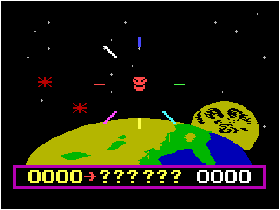 The Game: The game begins as the skull-like face of Spyruss the Deathless (the Timelord of Chaos, no less!) taunts you (well, only if you had the Voice), and then a bunch of pesky spaceships pops out of a vortex to shoot at you. They shoot at you rather a lot. Fortunately, you can shoot back with reckless abandon, but their ammunition – as you ascend into the higher levels of the game – can track you and even, if you don’t destroy their shots in mid-air, crawl along the ground briefly while you head for the opposite side of the screen, neatly trapped for their next volley. (Philips, 1983)
The Game: The game begins as the skull-like face of Spyruss the Deathless (the Timelord of Chaos, no less!) taunts you (well, only if you had the Voice), and then a bunch of pesky spaceships pops out of a vortex to shoot at you. They shoot at you rather a lot. Fortunately, you can shoot back with reckless abandon, but their ammunition – as you ascend into the higher levels of the game – can track you and even, if you don’t destroy their shots in mid-air, crawl along the ground briefly while you head for the opposite side of the screen, neatly trapped for their next volley. (Philips, 1983)
Memories: Known as Attack Of The Timelord outside of Europe and the U.K., this game was released abroard as Terrahawks+ for the Philips G7400+ console. It’s essentially the same game, except with a relatively elaborate background graphic of the Earth and moon (complete with the man in the moon, no less).
Ms. Pac-Man
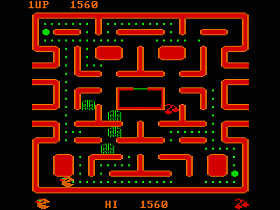 The Game: As the bride of that most famous of single-celled omniphage life forms, your job is pretty simple – eat all the dots, gulp the large blinking dots in each corner of the screen and eat the monsters while they’re blue, and avoid the monsters the rest of the time. Occasionally various fruits and other foods will bounce through the maze, and you can gobble those for extra points. (Atarisoft, 1983)
The Game: As the bride of that most famous of single-celled omniphage life forms, your job is pretty simple – eat all the dots, gulp the large blinking dots in each corner of the screen and eat the monsters while they’re blue, and avoid the monsters the rest of the time. Occasionally various fruits and other foods will bounce through the maze, and you can gobble those for extra points. (Atarisoft, 1983)
Memories: The early days of the IBM PC – which had, at this point, been on the market for two years – saw numerous software publishers trying to second-guess the PC’s position in the market. IBM’s a tech giant for businesses, but will this thing take off in the consumer market? If so, do we market entertainment software for it? Is it even suited to that sort of thing? And the answer to those questions, in 1983, was…well, maybe?
Zaxxon
 The Game: As the pilot of a lone fighter infiltrating a spaceborne fortress, your mission is simple – survive long enough to vanquish the evil Zaxxon robot hidden deep within the fortress, and take out as much of the defenses as you can in the meantime. (Datasoft, 1983)
The Game: As the pilot of a lone fighter infiltrating a spaceborne fortress, your mission is simple – survive long enough to vanquish the evil Zaxxon robot hidden deep within the fortress, and take out as much of the defenses as you can in the meantime. (Datasoft, 1983)
Memories: Probably the best of the early wave of translations of the groundbreaking arcade game, John Garcia’s Apple II edition of Zaxxon successfully boils the game down to its most vital elements: the basics of its graphical look and smooth, fast motion.
Xevious
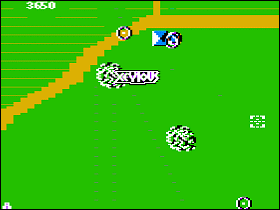 The Game: As the commander of a sleek Solvalou fighter, you’re deep into enemy territory, shooting their disc-shaped fighters out of the sky, bombing ground installations and artillery nests,bombing tanks, and trying to destroy the mothership. As you progress further behind enemy lines, heavier aircraft and more versatile and deadly ground-based defenses become the norm. (Mindscape, 1983)
The Game: As the commander of a sleek Solvalou fighter, you’re deep into enemy territory, shooting their disc-shaped fighters out of the sky, bombing ground installations and artillery nests,bombing tanks, and trying to destroy the mothership. As you progress further behind enemy lines, heavier aircraft and more versatile and deadly ground-based defenses become the norm. (Mindscape, 1983)
Memories: In the arcade, Xevious ushered in a whole new genre of vertical-scrolling shooters, a category that would grow to include hits like 1942, Dragon Spirit and Exed Exes – it would actually become a pretty crowded field. But the graphics and sound hardware of the Apple IIe, using a command set grandfathered in from the late ’70s, wasn’t exactly ideal for this new genre.
Super Demon Attack
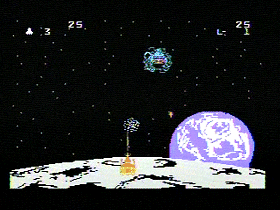 The Game: Demons coalesce into existence in mid-air above your cannon. Send them back where they came from by force. (Texas Instruments, under license from Imagic, 1983)
The Game: Demons coalesce into existence in mid-air above your cannon. Send them back where they came from by force. (Texas Instruments, under license from Imagic, 1983)
Memories: Somewhat similar to the Intellivision edition of Imagic’s Demon Attack in look and feel, this TI version of the game takes advantage of that computer’s graphics capabilities to turn the attacking demons into little pixellated pieces of Lovecraftian horror. It doesn’t make the game better or worse, really, but it adds a certain frisson to have nightmarish alien jellyfish-like critters descending upon you. Why Super Demon Attack? Because it’s got super demons, plain and simple.
Sammy Lightfoot
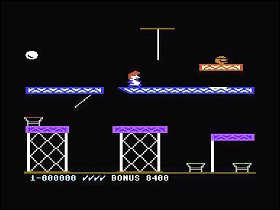 The Game: Help Sammy Lightfoot, circus performer extraordinaire, climb to the top of multiple levels by using trampolines, trapezes and your wits to avoid roaming meanies. (Sierra On-Line, 1983)
The Game: Help Sammy Lightfoot, circus performer extraordinaire, climb to the top of multiple levels by using trampolines, trapezes and your wits to avoid roaming meanies. (Sierra On-Line, 1983)
Memories: From the success of Nintendo’s Donkey Kong came, well, lots of games that were similar to Donkey Kong. And while Donkey Kong‘s plot (especially compared to the games of today) may seem incredibly simplistic, many of the clones that followed it had even less of one. Such is the case with Sammy Lightfoot. Like Mario in Donkey Kong, Sammy is a portly fellow who has been tasked with reaching the top of a series of platforms. The games box art and documentation describe Sammy as a circus performer, ostensibly to explain the trampolines and trapezes located on each level. This is where the plot ends, and the action begins.
Robotron: 2084
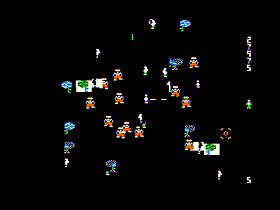 The Game: In the year 2084, all hell has broken loose on Earth. Robotic servants, created to perform dangerous tasks and defend their human creators, have decided they can do without their masters. The robots have evolved into new and terrifying varieties – the ever-multiplying Ground Roving UNit Terminators (GRUNTs), indestructible Hulks, self-replicating Quarks and Tanks, and most horrfying of all, the Brain robots, which capture humans and reprogram them into super-fast killing machines. And the only thing protecting the last remaining survivors of homo sapiens is your strength, endurance and cunning (and the multi-directional weaponry helps too). (Atarisoft, 1983)
The Game: In the year 2084, all hell has broken loose on Earth. Robotic servants, created to perform dangerous tasks and defend their human creators, have decided they can do without their masters. The robots have evolved into new and terrifying varieties – the ever-multiplying Ground Roving UNit Terminators (GRUNTs), indestructible Hulks, self-replicating Quarks and Tanks, and most horrfying of all, the Brain robots, which capture humans and reprogram them into super-fast killing machines. And the only thing protecting the last remaining survivors of homo sapiens is your strength, endurance and cunning (and the multi-directional weaponry helps too). (Atarisoft, 1983)
Memories: I loved the arcade version of Robotron. I loved the idea of it, the graphics, the sound effects…but there was one rather major problem between me and this game: I sucked at it. Pure and simple.
Pogo Joe
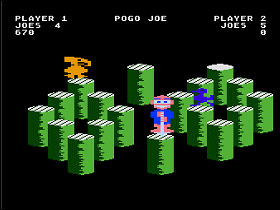 The Game: Pogo Joe has a pogo stick, a screen full of barrels whose colors need to be changed to the same target color, and a bunch of bouncy enemies too. Players guide Joe from barrel to barrel, sometimes requiring a big bounce if a barrel isn’t immediately adjacent to Joe’s current location, avoiding enemy creatures who are out to get him. Joe advances to the next level when the color of every barrel on the screen has been changed. A limited number of barrels per level act as a kind of “smart bomb” – landing on them wipes out all of Joe’s enemies temporarily (though they quitely repopulate the screen). (Screenplay, 1983)
The Game: Pogo Joe has a pogo stick, a screen full of barrels whose colors need to be changed to the same target color, and a bunch of bouncy enemies too. Players guide Joe from barrel to barrel, sometimes requiring a big bounce if a barrel isn’t immediately adjacent to Joe’s current location, avoiding enemy creatures who are out to get him. Joe advances to the next level when the color of every barrel on the screen has been changed. A limited number of barrels per level act as a kind of “smart bomb” – landing on them wipes out all of Joe’s enemies temporarily (though they quitely repopulate the screen). (Screenplay, 1983)
Memories: An obvious riff on the basic game play of Q*Bert, Pogo Joe rewrites the DNA of the original game more significantly than most knock-offs: the shape of the playing field changes from level to level (a trick that Q*Bert borrowed back when it made the jump to Game Boy Color), the cubes have become cylindrical barrels (and nicely drawn ones too, whether on the Atari computers or the Commodore 64), and in a few spectacularly frustrating screens, the barrels disappear completely, leaving the player with an almost unplayable screen if they haven’t planned their moves very, very carefully. In some ways, Pogo Joe is a game that Q*Bert experts could graduate to once they’ve mastered a pyramid of cubes.
Pac-Man
 The Game: As a round white creature consisting of a mouth and nothing else, you maneuver around a relatively simple maze, gobbling small dots and evading four colorful monsters who can eat you on contact. In four corners of the screen, large flashing dots enable you to turn the tables and eat the monsters for a brief period for an escalating score. Periodically, assorted items appear near the center of the maze, and you can consume these for additional points as well. The monsters, once eaten, return to their home base in ghost form and return to chase you anew. If cleared of dots, the maze refills and the game starts again, but just a little bit faster… (Atarisoft, 1983)
The Game: As a round white creature consisting of a mouth and nothing else, you maneuver around a relatively simple maze, gobbling small dots and evading four colorful monsters who can eat you on contact. In four corners of the screen, large flashing dots enable you to turn the tables and eat the monsters for a brief period for an escalating score. Periodically, assorted items appear near the center of the maze, and you can consume these for additional points as well. The monsters, once eaten, return to their home base in ghost form and return to chase you anew. If cleared of dots, the maze refills and the game starts again, but just a little bit faster… (Atarisoft, 1983)
Memories: Atari came by the code for its Apple II version of Pac-Man by the same means used by pirates of the high seas: they vanquished their foes and took their booty.
Pac-Man
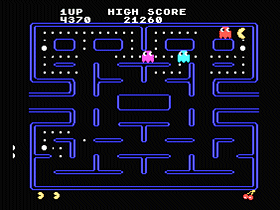 The Game: As a round yellow creature consisting of a mouth and nothing else, you maneuver around a relatively simple maze, gobbling small dots and evading four colorful monsters who can eat you on contact. In four corners of the screen, large flashing dots enable you to turn the tables and eat the monsters for a brief period. Periodically, assorted items appear near the center of the maze, and you can consume these for additional points as well. The monsters, once eaten, return to their home base in ghost form and return to chase you anew. If cleared of dots, the maze refills and the game starts again, but just a little bit faster… (Atarisoft, 1983)
The Game: As a round yellow creature consisting of a mouth and nothing else, you maneuver around a relatively simple maze, gobbling small dots and evading four colorful monsters who can eat you on contact. In four corners of the screen, large flashing dots enable you to turn the tables and eat the monsters for a brief period. Periodically, assorted items appear near the center of the maze, and you can consume these for additional points as well. The monsters, once eaten, return to their home base in ghost form and return to chase you anew. If cleared of dots, the maze refills and the game starts again, but just a little bit faster… (Atarisoft, 1983)
Memories: Having spent the better part of a year suing nearly every Pac-Man clone off the home video game market, Atari finally released its own version of the game for several consoles and home computer systems, including the TI 99/4a. TI had already released its own first-party take on the basic play mechanics of Pac-Man, Munch Man, which is generally considered one of the better arcade-style games released by TI itself. So did Atari’s “official” Pac-Man live up to its competition on the TI?
Night Stalker
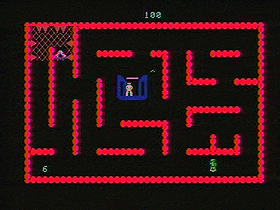 The Game: You’re alone, unarmed, in a maze full of bats, bugs and ‘bots, most of whom can kill you on contact (though the robots would happily shoot you rather than catching up with you). Loaded guns appear periodically, giving you a limited number of rounds with which to take out some of these creepy foes, though your shots are best reserved for the robots and spiders, who have a slightly more malicious intent toward you than the bats. If you shoot the bats, others will appear to take their place. If you shoot the ‘bots, the same thing happens, only a faster, sharper-shooting model rolls out every time. Your best bet is to stay on the move, stay armed, conserve your firepower – and don’t be afraid to head back to your safe room at the center of the screen. (Mattel Electronics, 1983)
The Game: You’re alone, unarmed, in a maze full of bats, bugs and ‘bots, most of whom can kill you on contact (though the robots would happily shoot you rather than catching up with you). Loaded guns appear periodically, giving you a limited number of rounds with which to take out some of these creepy foes, though your shots are best reserved for the robots and spiders, who have a slightly more malicious intent toward you than the bats. If you shoot the bats, others will appear to take their place. If you shoot the ‘bots, the same thing happens, only a faster, sharper-shooting model rolls out every time. Your best bet is to stay on the move, stay armed, conserve your firepower – and don’t be afraid to head back to your safe room at the center of the screen. (Mattel Electronics, 1983)
Memories: An adaptation of one of the Intellivision’s signature games, Night Stalker is actually one of the strongest titles in the tiny Aquarius game library. This isn’t to say that it’s a great port, just that it’s less bad than some of the other Aquarius games.
Ms. Pac-Man
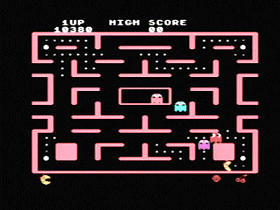 The Game: As the bride of that most famous of single-celled omniphage life forms, your job is pretty simple – eat all the dots, gulp the large blinking dots in each corner of the screen and eat the monsters while they’re blue, and avoid the monsters the rest of the time. Occasionally various fruits and other foods will bounce through the maze, and you can gobble those for extra points. (Atarisoft, 1983)
The Game: As the bride of that most famous of single-celled omniphage life forms, your job is pretty simple – eat all the dots, gulp the large blinking dots in each corner of the screen and eat the monsters while they’re blue, and avoid the monsters the rest of the time. Occasionally various fruits and other foods will bounce through the maze, and you can gobble those for extra points. (Atarisoft, 1983)
Memories: Introduced at virtually the same time as Atarisoft‘s TI edition of Pac-Man, Ms. Pac-Man looks and sounds slick – and has the same odd issue with slightly sluggish controls that seem to lag a little bit behind what’s happening on the screen.
Mr. Cool
 The Game: You’re Mr. Cool, an ice cube who chills out while hopping around a pyramid-shaped series of platforms. Fireballs streak across the pyramid from time to time, and they’ll melt you if they touch you. If you can stay cool long enough, you can advance through the game by changing the color of every platform to your target color by hopping onto each one – though in later levels it’ll take more than one hop, putting you in the path of more fireballs that could cause you to lose your cool. If you have one meltdown too many, the game is over. (Sierra On-Line, 1983)
The Game: You’re Mr. Cool, an ice cube who chills out while hopping around a pyramid-shaped series of platforms. Fireballs streak across the pyramid from time to time, and they’ll melt you if they touch you. If you can stay cool long enough, you can advance through the game by changing the color of every platform to your target color by hopping onto each one – though in later levels it’ll take more than one hop, putting you in the path of more fireballs that could cause you to lose your cool. If you have one meltdown too many, the game is over. (Sierra On-Line, 1983)
Memories: A classic case of making the best of a system’s limitations (and missing out on the official license for a popular arcade game), Mr. Cool is an unlikely collision of the game mechanics of Q*Bert and Frogger. And yet it works. In the company’s early days, Sierra was great at producing “near beer” games such as Mr. Cool and Crossfire (which approximated the game play of arcade cult classics Targ and Spectar).
Meteor Belt
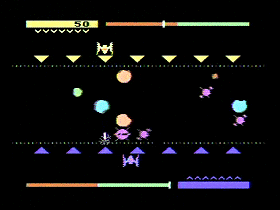 The Game: An evil force near the planet Jupiter has commandeered the asteroid belt between that giant planet and Mars as its personal defense shield. Your mission is simple: man a mobile weapons platform on the inner solar system’s side of the asteroid belt, exchange fire with the enemy (who can be the computer or another player), and try to knock out their defenses and destroy them. The battle will last only a brief time, and whoever has the best score – with a bonus given at the end for losing the least ships – wins. (Milton Bradley, 1983)
The Game: An evil force near the planet Jupiter has commandeered the asteroid belt between that giant planet and Mars as its personal defense shield. Your mission is simple: man a mobile weapons platform on the inner solar system’s side of the asteroid belt, exchange fire with the enemy (who can be the computer or another player), and try to knock out their defenses and destroy them. The battle will last only a brief time, and whoever has the best score – with a bonus given at the end for losing the least ships – wins. (Milton Bradley, 1983)
Memories: Milton Bradley is one of the few board game makers who didn’t at least try to make major in-roads into the video game arena. If anything, they tried to buy their way in, investing in and distributing the early models of the Vectrex stand-alone console, and later getting into Atari 2600 games with one-off specialty controllers that added to the games’ price without doing that much for game play.
Lode Runner
 The Game: Cavernous rooms are loaded with gold, just ripe for the picking. But before you celebrate hitting the mother lode, look again – there are other gold-diggers homing in on the treasure. What do you have that they don’t? A drill gun that can blast a hole in the floors, into which your opponents will jump blindly. Eventually, the holes will reseal themselves, and that process will swallow your enemies (and you, if you happen to be clumsy enough to wander into the hole yourself). Grabbing all of the gold will reveal a passage to the next level of the game. (Broderbund, 1983)
The Game: Cavernous rooms are loaded with gold, just ripe for the picking. But before you celebrate hitting the mother lode, look again – there are other gold-diggers homing in on the treasure. What do you have that they don’t? A drill gun that can blast a hole in the floors, into which your opponents will jump blindly. Eventually, the holes will reseal themselves, and that process will swallow your enemies (and you, if you happen to be clumsy enough to wander into the hole yourself). Grabbing all of the gold will reveal a passage to the next level of the game. (Broderbund, 1983)
Memories: Surely one of the “killer app” games of the early home computer era – right up there with anything in the Wizardry, Ultima or Infocom series – Lode Runner rocked my world way back when. I have to limit myself on praising this game, or this page is never gonna finish loading: it buries the needle on the excellence meters in both the action and puzzle genres, makes some of the best use ever of the Apple II’s hi-res graphics mode, and it even sounds good on the Apple (which is no small feat).
Lock ‘n’ Chase
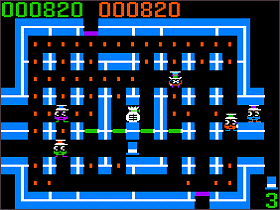 The Game: You’re in charge of a getaway car loaded with crafty criminals. Your job is to sneak around the maze, avoid four colorful cops who are hot on your trail, and grab all the dough – and, of course, to escape so you can steal again another day. But the cops can trap you with a series of doors that can prevent you from getting away… (M Network [Mattel Electronics], 1983)
The Game: You’re in charge of a getaway car loaded with crafty criminals. Your job is to sneak around the maze, avoid four colorful cops who are hot on your trail, and grab all the dough – and, of course, to escape so you can steal again another day. But the cops can trap you with a series of doors that can prevent you from getting away… (M Network [Mattel Electronics], 1983)
Memories: Released early in 1983, this version of Lock ‘N’ Chase further proves my “M Network theory,” which is as follows: somehow, no matter what hardware platform it’s on, an M Network game always winds up somehow looking like it’s a port of an Intellivision game. Not that this detracts from the fun factor of having a decent maze chase game on the Apple II, mind you.
Lode Runner
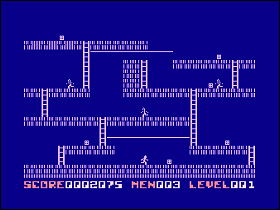 The Game: Cavernous rooms are loaded with gold, just ripe for the picking. But before you celebrate hitting the mother lode, look again – there are other gold-diggers homing in on the treasure. What do you have that they don’t? A drill gun that can blast a hole in the floors, into which your opponents will jump blindly. Eventually, the holes will reseal themselves, and that process will swallow your enemies (and you, if you happen to be clumsy enough to wander into the hole yourself). Grabbing all of the gold will reveal a passage to the next level of the game. (Broderbund, 1983)
The Game: Cavernous rooms are loaded with gold, just ripe for the picking. But before you celebrate hitting the mother lode, look again – there are other gold-diggers homing in on the treasure. What do you have that they don’t? A drill gun that can blast a hole in the floors, into which your opponents will jump blindly. Eventually, the holes will reseal themselves, and that process will swallow your enemies (and you, if you happen to be clumsy enough to wander into the hole yourself). Grabbing all of the gold will reveal a passage to the next level of the game. (Broderbund, 1983)
Memories: Originally designed and programmed on the Apple II, Lode Runner impressed Broderbund enough that ports to other systems were a high priority. But a major difference in the control scheme for the Apple and Atari computers caused Lode Runner to lose something in translation.
Juice!
 The Game: You’re the circuit maker, and they’re the circuit breakers. You hop around a maze-like structure, dropping circuitry patterns in your wake, as a variety of adversaries try to stop you from completing a circuit leading from the power source at your starting point to the receptacle across the maze from you. Colliding with any of them will cost you a life, but you can entice them to try to chase you off the maze and into oblivion while you escape safely. Completing the circuit advances you to the next maze – just on’t get too caught up in your power trip. (Tronix, 1983)
The Game: You’re the circuit maker, and they’re the circuit breakers. You hop around a maze-like structure, dropping circuitry patterns in your wake, as a variety of adversaries try to stop you from completing a circuit leading from the power source at your starting point to the receptacle across the maze from you. Colliding with any of them will cost you a life, but you can entice them to try to chase you off the maze and into oblivion while you escape safely. Completing the circuit advances you to the next maze – just on’t get too caught up in your power trip. (Tronix, 1983)
Memories: A neat combination of some well-worn game play elements, Juice is an eminently playable example of taking elements from different games and combining them into a new one. Bits of Pac-Man and Q*Bert, with a hint of Zaxxon‘s 3-D isometric perspective, combine to make Juice! unique and fun.
Gateway To Apshai
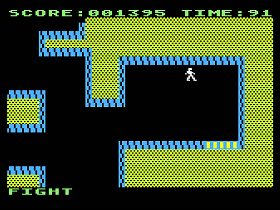 The Game: The player controls a weary adventurer weaving his way through a dungeon populated by treasures and deadly danger. Starting out with the clothes on his back, a short sword in hand, and adding what he can along the way, the player’s adventurer progresses through twisty mazes, vanquishes an increasingly dangerous rogues’ gallery of foes, and tries to gather a wealth of treasure… but even opening those treasure chests may reveal traps. (Epyx, 1983)
The Game: The player controls a weary adventurer weaving his way through a dungeon populated by treasures and deadly danger. Starting out with the clothes on his back, a short sword in hand, and adding what he can along the way, the player’s adventurer progresses through twisty mazes, vanquishes an increasingly dangerous rogues’ gallery of foes, and tries to gather a wealth of treasure… but even opening those treasure chests may reveal traps. (Epyx, 1983)
Memories: The Apshai computer RPGs form a kind of holy trinity of early adventure gaming along with the Ultima and Wizardry series of games. Gateway To Apshai is actually a prequel to the runaway hit Temple Of Apshai, which debuted on Tandy’s TRS-80 computer before cross-pollinating to every other platform under the sun. Gateway is missing Temple‘s famously wordy descriptions of its on-screen chambers, and as such feels completely different from the earlier game. But in hindsight, Gateway is an important step on the evolutionary road for the “action RPG” genre – paving the way for The Legend Of Zelda.
Frogger
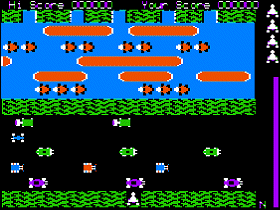 The Game: You are a frog. Your task is simple: hop across a busy highway, dodging cars and trucks, until you get the to the edge of a river, where you must keep yourself from drowning by crossing safely to your grotto at the top of the screen by leaping across the backs of turtles and logs. But watch out for snakes and alligators! (Sierra On-Line, 1983)
The Game: You are a frog. Your task is simple: hop across a busy highway, dodging cars and trucks, until you get the to the edge of a river, where you must keep yourself from drowning by crossing safely to your grotto at the top of the screen by leaping across the backs of turtles and logs. But watch out for snakes and alligators! (Sierra On-Line, 1983)
Memories: When I fired up Sierra’s rendition of Frogger for the Apple II for the first time in something like 25 years, old synapses that hadn’t fired in ages suddenly came to life once more. This was the very first game I got with my very first computer, back in the day – back when neither one was anywhere in the same neighborhood as “cheap.” So I have a great sentimental attachment to this version of Frogger.
Donkey Kong
 The Game: How high can you go? Help Jumpman (Mario) save Pauline from Donkey Kong’s clutches by climbing ladders and avoiding barrels. (AtariSoft, 1983)
The Game: How high can you go? Help Jumpman (Mario) save Pauline from Donkey Kong’s clutches by climbing ladders and avoiding barrels. (AtariSoft, 1983)
Memories: In 1980, Space Invaders became the first arcade game to be officially licensed to a home videogame system. Sales of both the game and the Atari 2600 console itself skyrocketed, thus giving birth to a genre that still exists and sells strongly today: the arcade port. For two years, Atari released ports of arcade games for their competitors’ systems under the brand name AtariSoft. AtariSoft focused predominantly on the expanding home computer market, porting popular arcade games such as Centipede, Dig Dug and Pac-Man to the Apple II, TI-99/4A, IBM PC, and of course the best game-playing machine of the era, the Commodore 64.
Doctor Who: The First Adventure
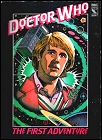 The Game: You guide the Doctor, that wayward Time Lord, on a quest to retrieve the three segments of the Key to Time, recover your companion from an alien prison, and escape aliens who are on your trail. The game appropriately takes place in four “episodes” (stages). Failing to complete a task will cost you time and a precious regeneration; running out of either one ends the game.
The Game: You guide the Doctor, that wayward Time Lord, on a quest to retrieve the three segments of the Key to Time, recover your companion from an alien prison, and escape aliens who are on your trail. The game appropriately takes place in four “episodes” (stages). Failing to complete a task will cost you time and a precious regeneration; running out of either one ends the game.
Memories: The first officially approved Doctor Who video game, The First Adventure isn’t a trendsetter or a great innovation in and of itself; in fact, I think it’s safe to say that this game for the BBC Micro would’ve been entirely un-noteworthy if not for the Doctor Who connection.
Dig Dug (Apple II)
 The Game: You are Dig Dug, an intrepid gardener whose soil is infested with pesky Pookas and fire-breathing Fygars. You’re armed with your trusty pump, which you can use to inflate your enemies until, finally, they blow up. But both the Pookas and Fygars can crawl through the ground and can pop out into your tunnels, and if Buy this gamea Fygar sneaks up behind you, he can toast you if you’re not careful. (Atarisoft, 1983)
The Game: You are Dig Dug, an intrepid gardener whose soil is infested with pesky Pookas and fire-breathing Fygars. You’re armed with your trusty pump, which you can use to inflate your enemies until, finally, they blow up. But both the Pookas and Fygars can crawl through the ground and can pop out into your tunnels, and if Buy this gamea Fygar sneaks up behind you, he can toast you if you’re not careful. (Atarisoft, 1983)
Memories: With the license already in-house at Atari (as part of the distribution deal that saw Atari handling the game in the U.S.), Atarisoft began cranking out versions of Dig Dug for competing home computer platforms. As often as not, however, the Apple versions of the games for which Atari had the license were a mixed bag.
Cavern Creatures
 The Game: Why do mountain climbers climb mountains? Because they’re there. Why are you flying a spacecraft into a vast complex of subterranean caverns? Because they’re there, and apparently because you want to blast the multitudes of critters who lurk there. The bad news: there are a lot more of them than there are of you. The good news? Your ship’s cannons fire in four directions simultaneously. Given that fact, and your ship’s maneuverability, you might just survive this little bit of aerial spelunking. (Datamost [designed by Paul Lowrance], 1983)
The Game: Why do mountain climbers climb mountains? Because they’re there. Why are you flying a spacecraft into a vast complex of subterranean caverns? Because they’re there, and apparently because you want to blast the multitudes of critters who lurk there. The bad news: there are a lot more of them than there are of you. The good news? Your ship’s cannons fire in four directions simultaneously. Given that fact, and your ship’s maneuverability, you might just survive this little bit of aerial spelunking. (Datamost [designed by Paul Lowrance], 1983)
Memories: These days, the ‘net is loaded with tributes to video games past and present. But Cavern Creatures was one of the first tributes to classic games, and it’s an interesting tribute – it too is playable.
Archon
 The Game: What if chess pieces were living creatures, each with its own unique abilities? And what if, every time to pieces met on the board, they had to fight amongst themselves to occupy the square in question? That’s Archon in a nutshell. (Electronic Arts, 1983)
The Game: What if chess pieces were living creatures, each with its own unique abilities? And what if, every time to pieces met on the board, they had to fight amongst themselves to occupy the square in question? That’s Archon in a nutshell. (Electronic Arts, 1983)
Memories: Whoever came up with this game is a total genius. This is the sort of game that won lots of fans in the early days who may not have necessarily been computer or video game afficionados – a modern variation on the game of chess, with arcade-flavored action segments to determine control of contested territories.
Apple Cider Spider
 The Game: You control a spider, wandering though a factory that makes cider, and to survive this trip you better be a good hider, for the spider can’t survive with any apples that might collide ‘er. The spider can become a rider on conveyor belts, but she can also fall off if the spider tries to jump over something wider than she can navigate. The goal is to help your spider reach home despite all the perils that would divide ‘er. (Sierra On-Line, 1983)
The Game: You control a spider, wandering though a factory that makes cider, and to survive this trip you better be a good hider, for the spider can’t survive with any apples that might collide ‘er. The spider can become a rider on conveyor belts, but she can also fall off if the spider tries to jump over something wider than she can navigate. The goal is to help your spider reach home despite all the perils that would divide ‘er. (Sierra On-Line, 1983)
Memories: A cute game requiring heaps of good timing, Ivan Strand’s Apple Cider Spider takes some staples of the platform/climbing genre, adds a few twists, and pours on the cute for good measure. It’s a delightful game that’s funny because nothing really violent can happen here, aside from stumbling into a few grisly ways to die here and there. (Well, grisly if you’re a spider.)
The Dreadnaught Factor
 The Game: Piloting a series of solo space fighters, you’re humanity’s last hope against a fleet of gigantic, triangular wedge-shaped battle cruisers bearing down on Earth. Launching from a staging area equipped with a hyperspace gate to fling your fighters into the void at top speed, you must strafe these cruisers in your fighter, bombing and blasting their gun emplacements, engines, and an assortment of weak spots on their ship. The enemy cruisers also have defensive fighters that they’ll launch to keep you from getting the job done, and of course the cruisers themselves are bristling with enormous laser cannons. Hitting all of the guns, engines and other “soft targets” on a cruiser will destroy it, giving you a momentary reprieve until the next cruiser arrives. If you run out of ships or fail to stop the enemy, they’ll wipe out your planet – game over, indeed. (Activision, 1982)
The Game: Piloting a series of solo space fighters, you’re humanity’s last hope against a fleet of gigantic, triangular wedge-shaped battle cruisers bearing down on Earth. Launching from a staging area equipped with a hyperspace gate to fling your fighters into the void at top speed, you must strafe these cruisers in your fighter, bombing and blasting their gun emplacements, engines, and an assortment of weak spots on their ship. The enemy cruisers also have defensive fighters that they’ll launch to keep you from getting the job done, and of course the cruisers themselves are bristling with enormous laser cannons. Hitting all of the guns, engines and other “soft targets” on a cruiser will destroy it, giving you a momentary reprieve until the next cruiser arrives. If you run out of ships or fail to stop the enemy, they’ll wipe out your planet – game over, indeed. (Activision, 1982)
Memories: Further proof that long before Lucasfilm ever entered the video gaming arena, George Lucas was having a massive ripple effect on the medium: the dreadnaughts in Dreadnaught Factor are – and let’s not kid ourselves here – clearly Star Destroyers. They’re shaped and laid out like them, right down to the control tower. If you ever wanted to see what would’ve happened if Han really had taken the Millennium Falcon into a head-to-head battle with a Star Destroyer, or if that poor sap in the A-Wing hadn’t been out of control, this is your game.